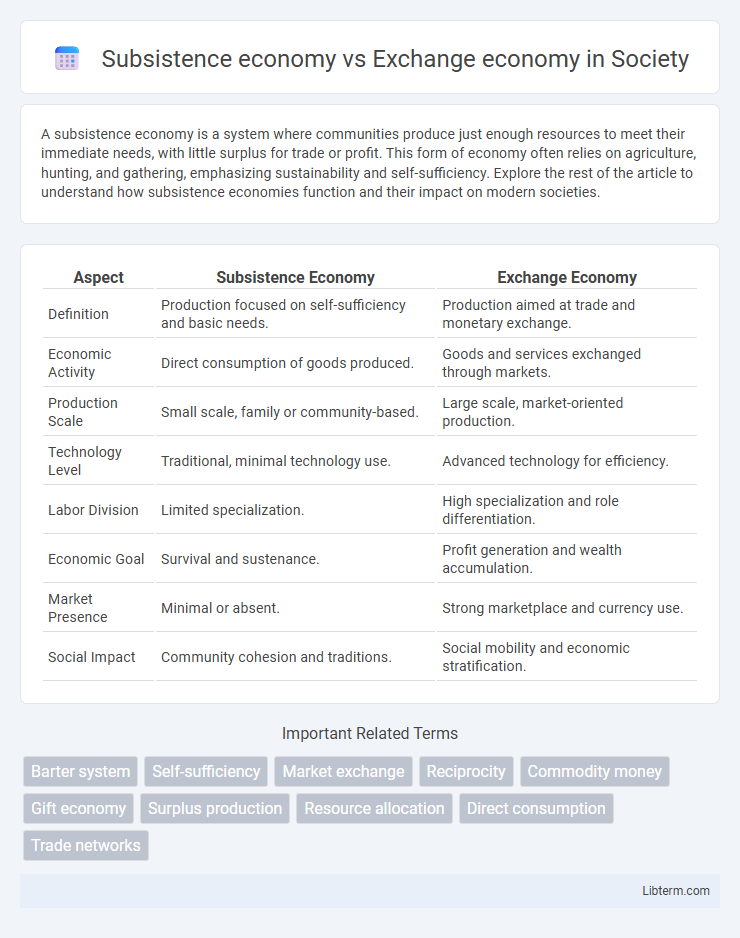A subsistence economy is a system where communities produce just enough resources to meet their immediate needs, with little surplus for trade or profit. This form of economy often relies on agriculture, hunting, and gathering, emphasizing sustainability and self-sufficiency. Explore the rest of the article to understand how subsistence economies function and their impact on modern societies.
Table of Comparison
| Aspect | Subsistence Economy | Exchange Economy |
|---|---|---|
| Definition | Production focused on self-sufficiency and basic needs. | Production aimed at trade and monetary exchange. |
| Economic Activity | Direct consumption of goods produced. | Goods and services exchanged through markets. |
| Production Scale | Small scale, family or community-based. | Large scale, market-oriented production. |
| Technology Level | Traditional, minimal technology use. | Advanced technology for efficiency. |
| Labor Division | Limited specialization. | High specialization and role differentiation. |
| Economic Goal | Survival and sustenance. | Profit generation and wealth accumulation. |
| Market Presence | Minimal or absent. | Strong marketplace and currency use. |
| Social Impact | Community cohesion and traditions. | Social mobility and economic stratification. |
Defining Subsistence Economy
A subsistence economy is defined by the production of goods and services primarily for direct consumption by the producer and their family, with little to no surplus for trade or sale. This economic system relies heavily on natural resources and traditional methods, emphasizing self-sufficiency and minimal external exchange. Unlike exchange economies, which focus on market transactions and surplus distribution, subsistence economies prioritize survival and local sustainability.
Understanding Exchange Economy
Exchange economy centers on the systematic trade of goods and services facilitated by a medium of exchange, such as money, enabling specialization and market-driven resource allocation. Unlike a subsistence economy, where production primarily fulfills direct consumption needs, exchange economies promote surplus production and complex economic interactions across regions. This economic model supports monetary transactions, credit systems, and price mechanisms that optimize efficiency and economic growth.
Key Characteristics of Subsistence Economies
Subsistence economies primarily rely on direct production for personal or community consumption, with minimal surplus generated for trade or sale. Key characteristics include small-scale production methods, reliance on natural resources, and a strong emphasis on self-sufficiency and tradition-based practices. These economies typically feature limited market interaction and prioritization of meeting basic needs over profit maximization.
Main Features of Exchange Economies
Exchange economies primarily involve the trading of goods and services through a system of markets, using money or other mediums of exchange to facilitate transactions. These economies are characterized by specialization, where individuals or groups focus on producing specific goods or services to trade for others, promoting efficiency and division of labor. Unlike subsistence economies, exchange economies rely on supply and demand dynamics and market mechanisms to allocate resources and determine prices.
Historical Evolution: From Subsistence to Exchange
Early human societies relied predominantly on subsistence economies, where communities produced goods primarily for their own consumption, ensuring survival through hunting, gathering, and small-scale farming. The historical evolution toward exchange economies emerged with the development of surplus production, enabling trade and specialization of labor within increasingly complex social structures. The transition marked a shift from self-sufficiency to market-oriented systems, fostering economic interdependence and the rise of monetary exchange as a medium of value.
Resource Management in Both Economies
Subsistence economies rely on self-sufficiency, where resource management centers on directly utilizing available natural resources for survival without surplus production or trade. Exchange economies emphasize efficient allocation and management of resources through market mechanisms, enabling surplus generation, specialization, and trade to optimize resource distribution. Sustainable resource management in subsistence systems focuses on conservation and traditional ecological knowledge, while exchange economies prioritize economic incentives, technological innovation, and regulatory frameworks to balance resource use and environmental impact.
Social and Cultural Impacts
Subsistence economies emphasize self-sufficiency, fostering tight-knit communities with strong cultural traditions and social bonds rooted in shared resource management and cooperative labor. Exchange economies promote individual economic activities and wealth accumulation, which can lead to social stratification, altered cultural values, and shifts in community cohesion as market participation drives social roles and identities. The transition from subsistence to exchange economy often transforms social structures, affecting cultural practices, social support systems, and collective responsibility.
Advantages and Limitations
Subsistence economies prioritize self-sufficiency, reducing dependency on external markets and promoting sustainability through localized production, but they often limit access to diverse goods and economic growth opportunities. Exchange economies facilitate specialization, innovation, and broader market access, driving economic expansion and increased consumer choice, while potentially causing inequality and market vulnerabilities. Understanding these economic systems' advantages and limitations helps tailor development strategies that balance local resilience with global integration.
Modern Examples and Case Studies
Subsistence economies, prevalent in remote Amazonian tribes and rural Himalayan villages, rely on self-sufficient agriculture and local resource use with minimal surplus for trade. Exchange economies dominate urban and global markets, exemplified by bustling stock exchanges in New York and technology-driven commerce in Shenzhen, China, where goods and services are traded for profit. Case studies of indigenous communities highlight challenges in integrating subsistence systems into broader exchange economies without eroding traditional lifestyles.
Future Trends and Economic Shifts
Subsistence economies, characterized by self-sufficiency and minimal trade, are increasingly influenced by technological advancements that enable modest integration with broader markets, fostering gradual economic shifts towards hybrid models. Exchange economies, driven by market transactions and specialization, are experiencing accelerated transformations through digital currencies, blockchain, and global supply chain innovations, enhancing transparency and efficiency. Future trends suggest a convergence where subsistence communities leverage exchange mechanisms for resilience, while exchange economies adopt sustainable practices inspired by subsistence principles to address environmental and social challenges.
Subsistence economy Infographic

 libterm.com
libterm.com